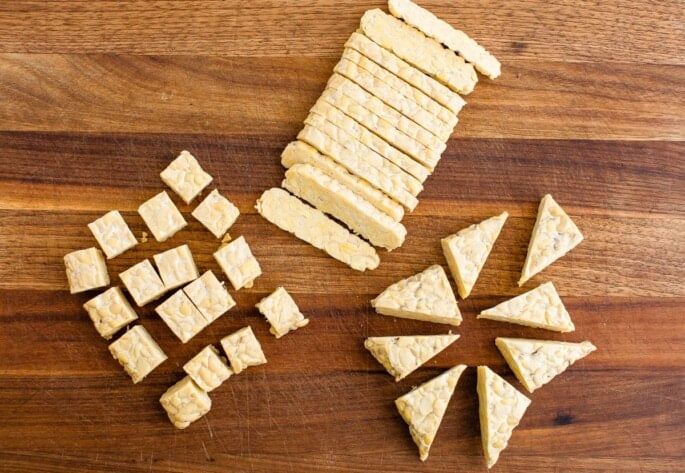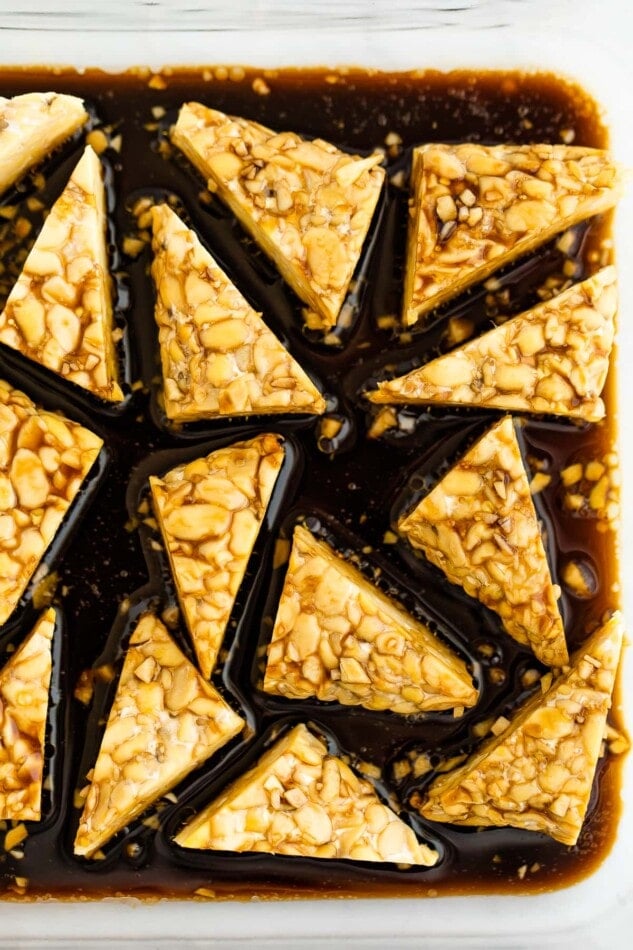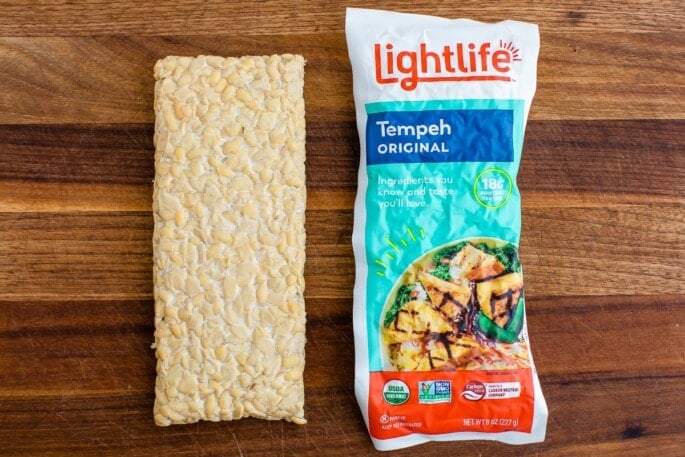If you’re new to tempeh, you’re in the right place because I have created a guide to teach you all about tempeh, it’s health benefits and how to cook it!
You may have seen some of my tempeh recipes and wondered what tempeh is. For starters, it’s a plant-based protein made of cooked soybeans (think edamame) that have been fermented. The fermentation process binds the soybeans into a cake/patty, which is what you’ll find at your local grocery store. Some varieties of tempeh only include soybeans, but others will contain grains like barley, rice, flax or millet along with the soybeans.
Simmer the tempeh to soften the flavor. Before using tempeh in any recipe, you can soften its bitter flavor by simmering the cubes for a couple minutes in the microwave or in a saucepan on the stove. An alternative to simmering: set a steamer basket in a pot and steam the cubes for 10 to 15 minutes.

Health Benefits of Tempeh
Tempeh is incredibly healthy! Not only is it a complete protein, but it’s a good source of iron, prebiotics, B vitamins and manganese. A 1 cup serving of tempeh has a whopping 31 grams of protein!!
As I mentioned above, tempeh is a fermented food. This fermentation process breaks down phytic acid, which can inhibit mineral absorption. This means the minerals in tempeh are easier to digest and tempeh is also less likely to cause gas or indigestion when compared to other beans. I don’t know about you, but less gas and bloating is always a win in my book!
Yes, tempeh is very healthy. It’s an excellent source of plant-based protein, prebiotics and a variety of vitamins and minerals, including iron.
Tempeh and tofu are both healthy options, however tempeh does provide more protein, fiber, iron, and potassium per serving when compared to tofu. It is also considered less processed than tofu. That said, tofu is lower in calories and does have more calcium per serving.
Most packaged tempeh is pasteurized so it is safe to eat raw, but it will taste much better if you cook it!
You can find tempeh at most major grocery stores now. Look for it in the refrigerated section, usually by the produce or other plant-based proteins.
Alright, so now that you know why you should be eating tempeh, let’s cover how to prepare and cook tempeh so you can feel confident next time you put a block of tempeh in your shopping cart.

There are so many different ways to cut tempeh, but here are my go-to methods:
- Thin slices: if I’m using tempeh to make my tempeh bacon, blackened tempeh salad or vegan breakfast sandwich I like to cut the tempeh into 1/4” thick strips/slices.
- Cubes or triangles: if the tempeh is the star of the recipe like in this vegan sweet and sour or tempeh butternut squash bake I like to cut it into cubes or triangles. For cubes, just try to keep cut them into the same sized cubes so they cook evenly. To cut tempeh into triangles, cut the tempeh in half width-wise. Cut each half in a star pattern to get 16 mini triangles per package of tempeh, 32 triangles total.
- Crumbled: crumbled tempeh is a great substitute for recipes that typically have ground meat like these tempeh tacos or this tempeh bolognese sauce. To crumble tempeh, simply break it apart with your hands until you reach a desired consistency, similar to that of ground meat.

What Does Tempeh Taste Like?
Tempeh on its own has a mild, nutty flavor that’s often described as earthy. Like most proteins, it really takes on the flavor of the dish! When prepared with marinades or sauces, it absorbs those flavors and the end result is so tasty.
Tempeh is related to tofu, but they aren’t the same thing! They are both made from soy, but other than that they’re actually quite different.
Tempeh is less processed, fermented and has a stronger flavor and a bit more texture. Tofu is more processed and has a milder flavor with basically no texture! Tofu can be blended up into a creamy sauce or soup or can be fried for more texture, but in general it is much smoother than tempeh.
I also find tempeh a bit easier to work with because there’s minimal prep work. With tofu you have to account for extra time to press it and with tempeh you simply open the package and you’re ready to chop and cook!

HOW TO COOK TEMPEH Without Pre-Boiling or Steaming (The ONLY Method You’ll Ever Need to Know)
FAQ
Should you steam or boil tempeh?
Does tempeh have to be steamed first?
Does tempeh need to be cooked before eating?
When preparing a dish with tempeh What first step is recommended?
Should I steam tempeh before cooking?
Steaming tempeh prior to cooking (using the methods below) helps remove any unwanted bitterness it may have. This is completely preference and optional. Set up a steamer basket over a pot of water and place the tempeh in the basket. Bring the water to a boil and let it steam for 10-15 minutes.
Tempeh vs Tofu: Which is healthier?
Tempeh and tofu are both healthy plant based protein options. One is not healthier than the other, they just have different nutritional components. Tofu tends to be flavourless and will take on the flavour of anything it is cooked with. Tofu is made from condensed soy milk. Tempeh on the other hand is made from fermented soybeans and has a slight nutty flavour.
Should tempeh be simmered before cooking?
Again, simmering tempeh prior to cooking (using the methods below) helps get rid of the bitterness of tempeh. This method is best prior to pan frying tempeh so that you can do it all in one pan.
Is tempeh good for frying?
Tempeh’s dense texture makes it perfectly suited to sautéing, grilling, baking in the oven, pan frying or air frying, as it will not disintegrate and crisps up beautifully. Tempeh’s dense texture makes it perfectly suited to sautéing, grilling, baking in the oven, pan frying or air frying.
